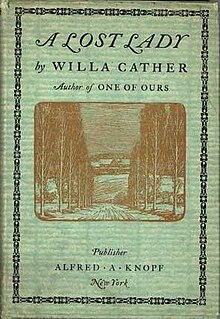A Lost Lady
 First edition | |
| Author | Willa Cather |
|---|---|
| Language | English |
| Publisher | Alfred A. Knopf |
Publication date | September 1923 |
| Publication place | United States |
| Media type | Print (Hardback) |
A Lost Lady is a 1923 novel by American writer
Plot summary
Niel Herbert, a young man who grows up in Sweet Water, witnesses the slow decline of Marian Forrester, for whom he feels very deeply, and also of the West itself from the idealized age of noble pioneers to the age of capitalist exploitation.
Major characters
- Niel Herbert – the main character who meets Mrs. Forrester as a young boy. He falls in love with what she represents and struggles to preserve his boyhood image of her. After watching her first have an affair with Frank Ellinger and later Ivy Peters, he finally leaves Sweet Water. Niel realizes by the end of the novel that his love of Marian was based on Captain Forrester's idealization of her.
- Mrs. Marian Forrester – a charming socialite and the wife of Captain Forrester. Niel falls in love with what she represents, and is dismayed to discover her affair with Frank Ellinger. After her husband's death, she becomes the mistress of Ivy Peters who runs her estate. She eventually leaves the town and moves to California, dying before Niel ever sees her again.
- Captain Daniel Forrester – an aging man of the Pioneer generation who made his fortune building track for the railroads in the old days. He is proud of his beautiful wife. The novel opens at a time when he has already been physically destroyed by a fall from a horse. After suffering two strokes he eventually dies, signifying the end of the pioneering era.
- Frank Ellinger – a muscular bachelor and businessman of the Gilded Age generation. Frank is Mrs. Forrester's lover and visits her when the Captain is away from the house. He marries Constance Ogden.
- Ivy Peters – a cocky and pretentious older boy of the Jazz Age generation who later becomes a lawyer. He becomes very wealthy and eventually succeeds in owning the Forrester estate.
- Constance Ogden – an envious Southern girl who is Niel's age and who is envious of Marian's beauty. She later marries Frank Ellinger.
- Judge Pommeroy – Niel's uncle, he is a lawyer that falls on hard times much the way the Forresters do.
Literary significance and criticism

The novel has a robust symbolic framework.[3] Critical approaches have noted that the character of Marian Forrester symbolically embodies both the American Dream,[4][5] as well as the gradual decline of the American West.[6]
Legacy and influence
The novel had an acknowledged influence on writer F. Scott Fitzgerald who borrowed many of its themes and elements.[2] Marian Forrester, in particular, partly inspired his Daisy Buchanan character in The Great Gatsby.[2] Fitzgerald later wrote a letter to Cather apologizing for any unintentional plagiarism.[2]
Media adaptations
The first film version of the novel was created in 1924, adapted by Dorothy Farnum.[7] Directed by Harry Beaumont, the film starred Irene Rich, Matt Moore, June Marlowe, and John Roche.[7] It would also be adapted very loosely into a film of the same name in 1934 by Gene Markey, and starred Barbara Stanwyck as Marian Forrester.[8] The film did not live up to the novel's reputation and is generally regarded as mediocre.[8] Cather was so displeased with the film that she forbade any further film or stage adaptations of her work.[9]
References
Citations
- ^ Rosowski 1977, p. 51: "Mrs. Forrster's decline parallels the West's decline; the novel becomes an elegy for the pioneer past".
- ^ a b c d Quirk 1982, p. 578; Bruccoli 1978, pp. 171–72.
- ^ Rosowski 1977, p. 51; Harvey 1995, p. 76; Funda 1995, p. 275.
- ^ Harvey 1995, p. 76: "Marian Forrester, then, represents the American Dream boldly focused on self, almost fully disengaged from the morals and ethics to which it had been tied in the nineteenth century".
- ^ Funda 1995, p. 275.
- ^ Rosowski 1977, p. 51.
- ^ a b A Lost Lady 1924.
- ^ a b A Lost Lady 1934.
- ^ Fuller 2019.
Works cited
- "A Lost Lady (1924)". Los Angeles, California: American Film Institute. Retrieved July 16, 2021.
- "A Lost Lady (1934)". Los Angeles, California: American Film Institute. Retrieved July 16, 2021.
- JSTOR 26402223.
- Fuller, Jaime (December 17, 2019). "Looking at Willa Cather's West". Jezebel. New York City. Retrieved August 16, 2020.
- Funda, Evelyn I. (Fall 1995). "Review of 'Redefining the American Dream: The Novels of Willa Cather'". Great Plains Quarterly. 15 (4). Lincoln, Nebraska: JSTOR 23531702.
- Harvey, Sally Peltier (1995). Redefining the American Dream: The Novels of Willa Cather. Florham Park, New Jerse: ISBN 9780838635575.
- Quirk, Tom (December 1982). "Fitzgerald and Cather: The Great Gatsby". JSTOR 2926007. Retrieved May 25, 2021.
- Rosowski, Susan J. (Autumn 1977). "Willa Cather's 'A Lost Lady': The Paradoxes of Change". Novel: A Forum on Fiction. 11 (1). Durham, North Carolina: JSTOR 1344886.
External links
- A Lost Lady at Project Gutenberg
- A Lost Lady at the Internet Archive
 A Lost Lady public domain audiobook at LibriVox
A Lost Lady public domain audiobook at LibriVox- A Lost Lady at the IMDB
